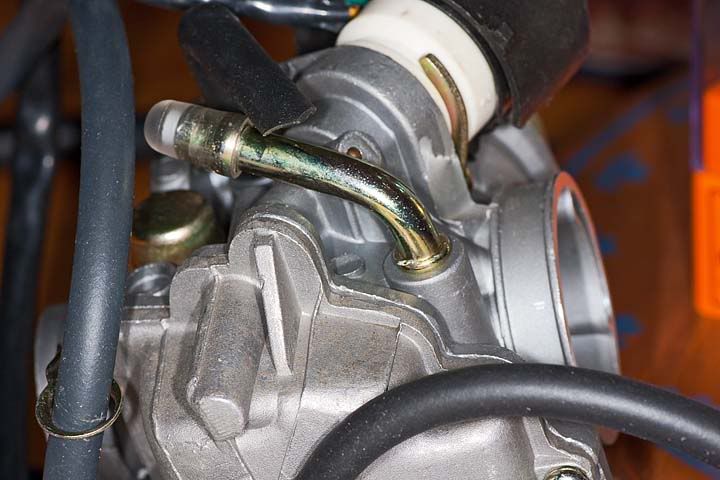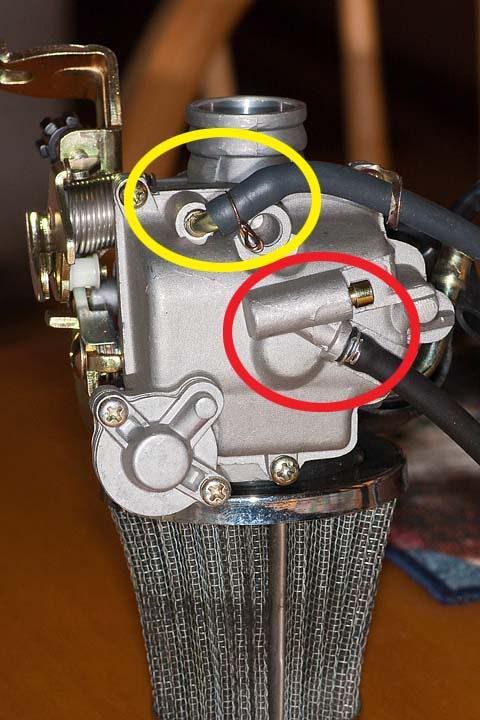|
|
Post by defrogi on Jan 5, 2011 4:06:49 GMT -5
I got a new 23mm carb for my 4 stroke 50cc scoot. It has a 52mm big bore kit with performance head and cam, performance air filter, no rev limit CDI - high output coil, iridium plug, performance exhaust, performance variator and clutch, Dr. Pulley 6g sliders and a Bad Boy horn that is bad to the bone! The new carb has a brass tube with a plastic cap that I can't figure out what it is for. There is a hose connected to the bowl drain port and a hose connected to the fuel line in. I got the carb from Scrappy Dog and have emailed them asking this same question but have not as yet received a response. I also posted this on three other scooter forums and no one seems to know the answer yet. Here are pics of the carb. This is the tube in question.  Yellow outline is fuel line. Red outline is bowl drain line.  This is a pic of the bottom of the carb.  |
|
|
|
Post by 90GTVert on Jan 5, 2011 8:26:39 GMT -5
:welcome2:
I've never seen one like that, but I believe the first pic (the tube in question) is the fuel line in. You are correct for sure on the red-circled drain hose. I'm not sure if the yellow hose is n overflow of some sort or what that would be. If it were mine, I'd pull the bowl off and find out for sure. If you blow through the line that is for fuel delivery to the bowl, you will feel air coming into the bowl from the passage that your float needle and seat are in. You can remove the float or just hold the carb right side up so the float would not be blocking flow in to check. Simply looking at where the other hose meets up might give you a better idea of what it does.
|
|
|
|
Post by lackthereof on Jan 5, 2011 8:46:33 GMT -5
Got a picture under the air-filter?
If this carb has an emissions-legal application on a stock bike somewhere, it's possible that capped tube simply leads to open air between the filter and the slide. That clean air is where the crankcase generally vents to on emissions-controlled machines.
Sometimes the crank vent is hooked up to a nipple on the ductwork between the carb and filter, but it's not unheard of for it to hook right up to a tube on the air filter horn of the carb. Simplifies maintaining full emissions-legality when changing to a direct-mount air filter.
No promises, though. I'm assuming you correctly identified the other two hoses, and I have no factual data whatsoever.
|
|
|
|
Post by defrogi on Jan 5, 2011 11:56:36 GMT -5
I'm still waiting for a response from Scrappy Dog tech cuz they "should" know ;-)
Thanks for the input :-)
|
|
|
|
Post by stepthrutuner on Jan 6, 2011 1:34:42 GMT -5
 I've never seen one like that, but I believe the first pic (the tube in question) is the fuel line in. You are correct for sure on the red-circled drain hose. I'm not sure if the yellow hose is n overflow of some sort or what that would be. If it were mine, I'd pull the bowl off and find out for sure. If you blow through the line that is for fuel delivery to the bowl, you will feel air coming into the bowl from the passage that your float needle and seat are in. You can remove the float or just hold the carb right side up so the float would not be blocking flow in to check. Simply looking at where the other hose meets up might give you a better idea of what it does. I agree with Brent (90GTVert). The position of the tube entrance into the carb body is appropriate (near the reduced dimension of the float bowl where the float hinge/fuel entrance/inlet valve would be) for fuel entrance to the carb. I've never seen one enter the body horizontally like that one though. What piques my curiosity is the white plug-like plastic object in the end of the tube (a small strainer maybe?). I'm assuming the tube was capped for for the purpose of keeping debris out of float valve seat during storage and shipment. Were the line encircled in yellow to be for the purpose of overflow, one would have to ensure that it slope downward to the point of it's outlet for it to function properly. My guess is that it is for the purpose of evaporative emissions control and would possibly be routed back to the top of the gas tank with a check valve to prevent back flow from the gas tank in the event of over filling or expansion of the gasoline due to temperature or it may have gone to a vapor cannister with a purge mechanism to vent to the pre carburetor intake track. If Fox hasn't already straightened us out on this matter by the time I post this then he probably will soon. |
|
|
|
Post by 90GTVert on Jan 6, 2011 7:58:02 GMT -5
I agree with step and lack on the yellow hose. I never even think about emissions on scoots since none of my 4 or others I've worked on have had much in the way of evaporative emission control. That does sound more likely than an overflow. Overflows should be up top anyway (the port with the downward facing cut-off hose).
|
|
|
|
Post by defrogi on Jan 6, 2011 8:03:34 GMT -5
thanks for all the input. Scrappy Dog finally emailed me and the brass tube with the cap on it IS the fuel in port. He failed to mention what the second brass tube was for (the one with a hose attached) but I suspect you are correct about emissions and I'm going to try it using the plastic cap that is currently on the fuel line to cap off the brass tube coming out of the bottom of the carb.
|
|